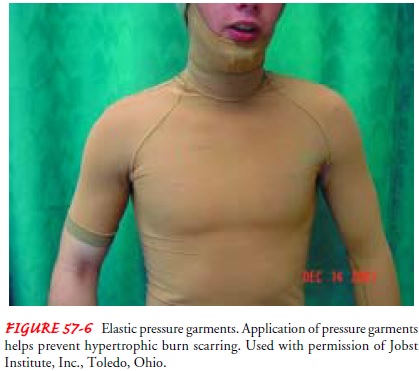Chapter: Medical Surgical Nursing: Management of Patients With Burn Injury
Rehabilitation Phase of Burn Care
REHABILITATION PHASE OF BURN CARE
Although
long-term aspects of burn care are discussed last, rehabilitation begins
immediately after the burn has occurred—as early as the emergent period—and
often ex-tends for years after injury. In the aftermath of the acute stages of
injury, the burn patient increasingly focuses on the alter-ations in self-image
and lifestyle that may occur. Wound heal-ing, psychosocial support, and
restoring maximal functional activity remain priorities. The focus on
maintaining fluid and electrolyte balance and improving nutritional status
continues. Reconstructive surgery to improve body appearance and func-tion may
be needed.
Burn
injuries can have a major impact on quality of life. Changes in physical
activity and social, psychological, and em-ployment status may occur.
Therefore, psychological and voca-tional counseling and referral to support
groups may be helpful to promote recovery and quality of life. Family members
also need support and guidance in assisting the patient to return to optimal
health.
Prevention of Hypertrophic Scarring
The wound is in a dynamic state for 1.5 to 2 years
after the burn occurs. If appropriate measures are instituted during this
active period, the scar tissue loses its redness and softens. Healed areas that
are prone to hypertrophic scarring require the patient to wear a pressure
garment (Fig. 57-6). These devices are especially use-ful for partial-thickness
wounds that required more than 2 weeks to heal and for the edges of grafted
skin. Applying elastic pressure garments loosens collagen bundles and
encourages parallel orien-tation of the collagen to the skin surface, with the
disappearance of the dermal nodules. As pressure continues over time, there is
a restructuring of the collagen and a decrease in vascularity and cel-lularity
(Serghiou, Young, Ott et al., 2002).

The physical therapist, occupational therapist, or
a representa-tive of the manufacturer of elastic pressure garments measures the
patient for correct fit. While awaiting the arrival of the garment, soft,
tubular, knitted elastic pressure bandages can be used to help desensitize the
patient’s skin, protect healing areas, apply pressure, and promote venous
return. Patients must be instructed about the need for lubrication and
protection of the healing skin and the need for pressure garments for at least
a year after the injury. A program including elastic pressure garments,
splints, and exercise under the supervision of an experienced physical and occupational
therapy team is recommended for optimal functional and cosmetic results.
Related Topics